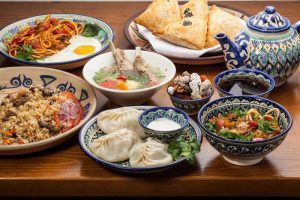Uzbek culture is one of the most ancient and refined in Central Asia. One particulary distinctive and well-developed aspect of Uzbek culture is the national cuisine. Unlike its nomadic neighbours, the Uzbeks have had a settled civilization for centuries. Between the deserts and mountains, in the oasis and fertile valleys, Uzbeks cultivated grain and domesticated livestock. The resulting abundunce of produce allowed them to express their strong tradition of hospitality, which in turn enriched Uzbek cuisine.
The winter diet traditionally consists of dried fruits, vegetables and preserves. Hearty noodle or pasta-type dishes are also common chilly-weather fare.

Bread is sacred to Uzbek people. Traditionally Uzbek breads are baked inside the stoves made of clay called “Tandyr.” These fragrant breads are quite crispy and tasty. Even medicine’s greatest scientist, Avicenna, used Uzbek bread to cure people of diseases. The wide array of breads, leavened and unleavend, is a staple for the majority of the population. Flat bread, or non, is usually baked in tandoor ovens, and served with tea, not to mention at every meal. Some varieties are prepared with onions or meat in the dough, others topped with sesame seeds or kalonji.
Palov, the Uzbek version of “pilaf,” is the flagship of cookery. Uzbek “pilaf” is a very highly regarded food, considered both as an everyday dish as well as a meal for solemn and great events like weddings, parties, and holidays. Neither a friendly dinner nor funeral repast can be held without palov. Dishes made of rice are known almost in every country of the East, but the Uzbek palov recipe, which was created in ancient times, can be called the masterpiece of culinary art.
There are more than 50 varieties of palov in Uzbek cuisine: with meat or chicken, peas or potatoes; cooked in the steamer or in sheep fat; and regional variants, with quince or garlic. The ancient recipes of palov with quails and raisins, or palov made of rice of waxy ripeness have been preserved unchanged since the 10th -12th centuries, whereas some techniques of making “classical palov” are a thousand years old.
Special importance is placed on soups. Uzbek soup is rich in vegetables and seasonings and contains an abundance of carrots, turnips, onions and greens. Two popular soups are Mastava and Shorva.
Tea is revered in the finest oriental traditions. It is offered first to any guest and there exists a whole subset of mores surrounding the preparation, offering and consuming of tea. Green tea is the drink of hospitality and predominant. Black tea is preferred in Tashkent, though both teas are seldom taken with milk or sugar. An entire portion of their cuisine is dedicated solely to tea drinking. Some of these include samsa, bread, holva, and various fried foods.
The choyhona or teahouse is a cornerstone of traditional Uzbek society. Always shaded, preferably situated near a cool stream, the choyhona is gathering place for social interaction and fraternity. Robed Uzbek men congregate around low tables centered on beds adorned with ancient carpets, enjoing delicious palov, kebab and endless cups of green tea


